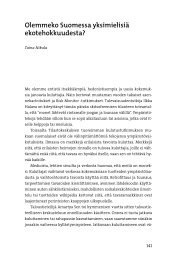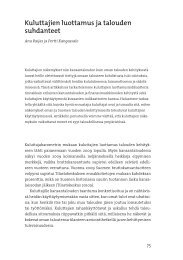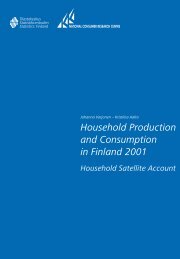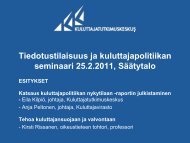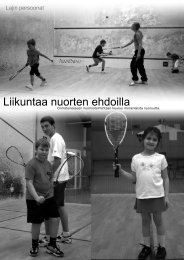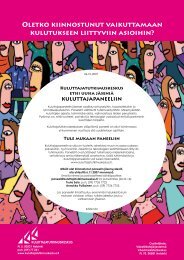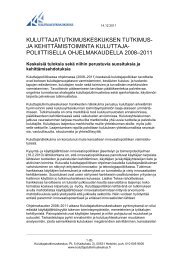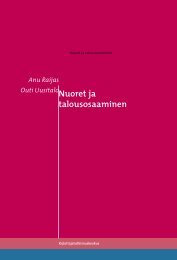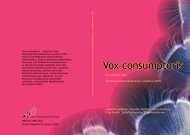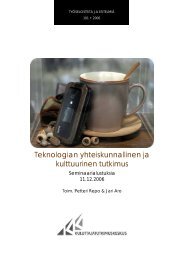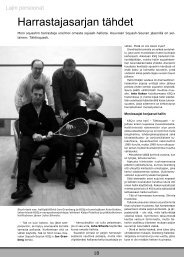Household Production and Consumption in Finland 2001
Household Production and Consumption in Finland 2001
Household Production and Consumption in Finland 2001
You also want an ePaper? Increase the reach of your titles
YUMPU automatically turns print PDFs into web optimized ePapers that Google loves.
45 <strong>and</strong> families with schoolchildren, the value of f<strong>in</strong>al consumption products<br />
was around 70 per cent of the value of production. Expenditure on clothes <strong>and</strong><br />
their care was highest <strong>in</strong> families with schoolchildren, with spend<strong>in</strong>g<br />
amount<strong>in</strong>g to more than 2,500 euros a year. The differences seen between<br />
different household types suggest that young people <strong>and</strong> families with children<br />
spend quite a lot of money on clothes, whereas older people buy less clothes<br />
but devote more time to cloth<strong>in</strong>g care.<br />
Care ofchildren <strong>and</strong> adults<br />
In families with children under school age, the value of childcare was <strong>in</strong> a class<br />
all its own. In fact, he figure was higher than that for SNA hous<strong>in</strong>g or meals<br />
<strong>and</strong> snacks at almost 13,400 euros (note that the scale <strong>in</strong> Figure 21 is different<br />
from the scale <strong>in</strong> Figure 20). In these families the value of childcare was<br />
around four times higher than <strong>in</strong> families with schoolchildren <strong>and</strong> almost three<br />
times higher than <strong>in</strong> s<strong>in</strong>gle-parent families.<br />
One factor which reduces the value of childcare <strong>and</strong> the care of adults is<br />
that allowances paid out to families are subtracted from the value of labour<br />
(regarded as subsidies). On average, families with small children got almost<br />
2,500 euros a year <strong>in</strong> care allowances, for s<strong>in</strong>gle-parent families the figure was<br />
almost 270 euros. In other types of households care allowances are much<br />
smaller. It also needs to be borne <strong>in</strong> m<strong>in</strong>d that the public sector subsidises a<br />
significant proportion of children’s day care, <strong>and</strong> consequently households only<br />
have to pay for part of the f<strong>in</strong>al consumption products <strong>in</strong> this pr<strong>in</strong>cipal<br />
function.<br />
Travel <strong>and</strong> services accounted for over one-half of the value of care for<br />
adults. For people liv<strong>in</strong>g alone, travel <strong>and</strong> services related to care were<br />
allocated to car<strong>in</strong>g for pets s<strong>in</strong>ce there are no other (permanent) residents <strong>in</strong><br />
these households. These people do, however, have pets, which will<br />
occasionally need to be taken to the vet, for example.<br />
Figure 21. Non-SNA production of the care of children <strong>and</strong> adults <strong>and</strong> purchased services<br />
by type of household<br />
€/ /household /year<br />
16,000<br />
Travel <strong>and</strong> services<br />
14,000<br />
Gross value added<br />
12,000 Intermediate consumption<br />
10,000 Purchases for f<strong>in</strong>al consumption<br />
8,000<br />
6,000<br />
4,000<br />
2,000<br />
0<br />
Under 45 45–64 65+ Under 45 45–64 65+ S<strong>in</strong>gle Youngest Youngest Others<br />
yrs yrs yrs yrs yrs yrs parents 0–6 7–17<br />
Persons liv<strong>in</strong>g alone Couples<br />
Families with children<br />
56 Statistics F<strong>in</strong>l<strong>and</strong> National Consumer Research Centre




